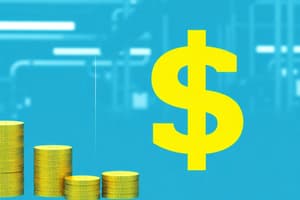Podcast
Questions and Answers
What does the term 'economies of scale' refer to?
What does the term 'economies of scale' refer to?
- Decrease in variable costs as production increases
- Cost advantages gained from increased production (correct)
- Increase in fixed costs with production scale
- Higher prices for larger firms
Managerial economies do not contribute to lowering costs.
Managerial economies do not contribute to lowering costs.
False (B)
Name one type of economies of scale.
Name one type of economies of scale.
Technical Economies
__________ economies refer to reduced marketing costs due to a larger customer base.
__________ economies refer to reduced marketing costs due to a larger customer base.
Which of the following is an example of financial economies?
Which of the following is an example of financial economies?
Match the type of economies of scale with its description:
Match the type of economies of scale with its description:
Increasing marginal returns occur when additional inputs lead to a smaller increase in output.
Increasing marginal returns occur when additional inputs lead to a smaller increase in output.
The long-run average total cost curve represents the lowest cost per unit at which any __________ could be produced.
The long-run average total cost curve represents the lowest cost per unit at which any __________ could be produced.
What is one reason larger firms can negotiate better deals with suppliers?
What is one reason larger firms can negotiate better deals with suppliers?
Economies of scale can be achieved through the indivisibility of inputs.
Economies of scale can be achieved through the indivisibility of inputs.
Describe how division of labor contributes to economies of scale.
Describe how division of labor contributes to economies of scale.
Large businesses can use ______ machinery to increase their production efficiency.
Large businesses can use ______ machinery to increase their production efficiency.
What type of costs are considered one-time costs that larger firms can utilize effectively?
What type of costs are considered one-time costs that larger firms can utilize effectively?
Match the following concepts with their descriptions:
Match the following concepts with their descriptions:
Small businesses typically benefit more from economies of scale than large businesses.
Small businesses typically benefit more from economies of scale than large businesses.
What is diminishing marginal return?
What is diminishing marginal return?
What does the law of returns to scale describe?
What does the law of returns to scale describe?
Increasing marginal returns occur when an additional input leads to a proportionally greater increase in output.
Increasing marginal returns occur when an additional input leads to a proportionally greater increase in output.
Define diminishing marginal returns.
Define diminishing marginal returns.
In the short run production function, at least one input must be ______.
In the short run production function, at least one input must be ______.
Match the terms with their definitions:
Match the terms with their definitions:
Which of the following is a result of a reduction in the price of electricity for a firm?
Which of the following is a result of a reduction in the price of electricity for a firm?
A reduction in the wage rate will likely decrease the firm’s production capacity in the short run.
A reduction in the wage rate will likely decrease the firm’s production capacity in the short run.
What effect does an increase in rent have on a firm’s production costs?
What effect does an increase in rent have on a firm’s production costs?
Flashcards
Economies of scale
Economies of scale
Cost advantages a firm gains by increasing production and expanding operations, leading to lower average total cost in the long run.
Long-run average cost
Long-run average cost
Lowest cost per unit at which any output can be produced in the long run.
Technical Economies
Technical Economies
Cost savings arising from efficient use of production methods and technology, like advanced machinery and automation.
Managerial Economies
Managerial Economies
Signup and view all the flashcards
Financial Economies
Financial Economies
Signup and view all the flashcards
Marketing Economies
Marketing Economies
Signup and view all the flashcards
Purchasing Economies
Purchasing Economies
Signup and view all the flashcards
Output
Output
Signup and view all the flashcards
Indivisibility of Inputs
Indivisibility of Inputs
Signup and view all the flashcards
Division of Labor
Division of Labor
Signup and view all the flashcards
Specialized Machinery
Specialized Machinery
Signup and view all the flashcards
One-Time Costs
One-Time Costs
Signup and view all the flashcards
Diversification Economies
Diversification Economies
Signup and view all the flashcards
Supplier Negotiation
Supplier Negotiation
Signup and view all the flashcards
Resource Waste
Resource Waste
Signup and view all the flashcards
Law of Returns to Scale
Law of Returns to Scale
Signup and view all the flashcards
Increasing Returns to Scale
Increasing Returns to Scale
Signup and view all the flashcards
Constant Returns to Scale
Constant Returns to Scale
Signup and view all the flashcards
Decreasing Returns to Scale
Decreasing Returns to Scale
Signup and view all the flashcards
What happens when electricity prices fall?
What happens when electricity prices fall?
Signup and view all the flashcards
What happens when wages decrease?
What happens when wages decrease?
Signup and view all the flashcards
What happens when CEO salary increases?
What happens when CEO salary increases?
Signup and view all the flashcards
What happens when rent increases?
What happens when rent increases?
Signup and view all the flashcards
Study Notes
Introduction to Cost & Production
- Cost and production is a theory in economics
- Production firms are involved in manufacturing goods
- The life cycle of a production firm has two main periods: short-run and long-run
Short-Run vs. Long-Run Production
- Short run: At least one factor is fixed, while others are variable.
- Timeframe too short for capital adjustments
- Labor and materials can be changed.
- Long run: All factors are variable.
- Firms can adjust production capacity, facilities, technology, and other fixed factors.
Production Function
- A production function shows the relationship between inputs and output.
- It's a mathematical or graphical representation displaying input combinations for specific output levels.
Laws of Marginal Returns
- Marginal returns represent extra output from adding a variable resource (e.g., labor) to a fixed resource.
- Increasing marginal returns: Adding more variable inputs initially leads to proportionally larger increases in output.
- Diminishing marginal returns: Adding more variable inputs eventually leads to smaller increases in output.
- These laws are important in short-run production decisions.
Production Curves
- Marginal product curve: Shows the change in output from adding one more unit of a variable input.
- Total product curve: Shows the total output produced given various variable input quantities.
- Average product curve: Shows the average output produced per unit of the variable input.
- The relationship between marginal product and average product curves shows when output levels are rising or falling.
Relationship between Marginal Cost and Average Curves
- Marginal cost (MC) curve intersects both average total cost (ATC) and average variable cost (AVC) curves at their minimum points.
- When marginal cost is below average cost, average cost will decrease.
- When marginal cost is above average cost, average cost will increase.
Relationship between Total Fixed Cost and Average Fixed Cost
- Total fixed cost (TFC) curve is horizontal, as fixed costs remain constant.
- Average fixed cost (AFC) curve is downward sloping as output increases.
Relationship between Total Variable Cost and Total Cost
- Total variable cost (TVC) curve slopes upwards as output increases and becomes steeper as output rises further.
- Total cost (TC) curve is the sum of TFC and TVC curves.
Impact of Factors on Cost Curves
- Price reductions for factors like electricity or labor generally decrease average total cost and average variable cost.
- Increases in factors such as rent increase average total cost.
Returns to Scale
- Increasing returns to scale: Output increases more than proportionally to inputs.
- Constant returns to scale: Output increases proportionally to inputs.
- Decreasing returns to scale: Output increases less than proportionally to inputs.
Economies of Scale
- Economies of scale are cost advantages from expanding production on a larger scale.
- Factors include technical, managerial, financial, marketing, and purchasing economies.
Minimum Efficient Scale
- Minimum efficient scale (MES) of production is the smallest level of output at which a firm can produce at lowest possible average cost.
Accounting Profit vs. Economic Profit
- Accounting profit: Revenue minus explicit costs.
- Economic profit: Revenue minus both explicit and implicit costs (includes opportunity costs).
Studying That Suits You
Use AI to generate personalized quizzes and flashcards to suit your learning preferences.



